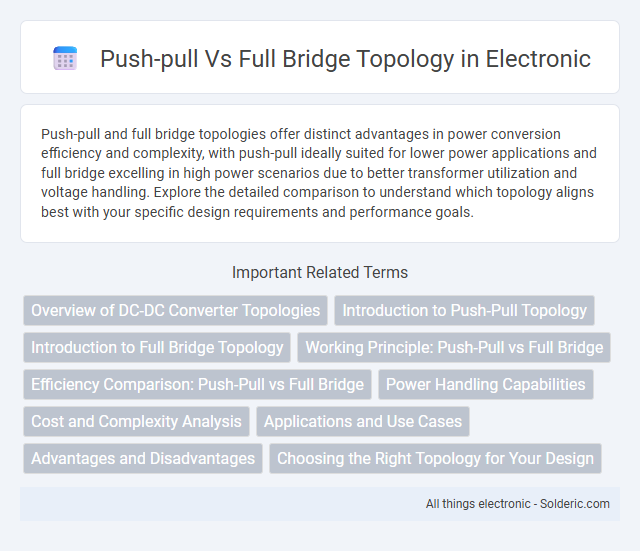Push-pull and full bridge topologies offer distinct advantages in power conversion efficiency and complexity, with push-pull ideally suited for lower power applications and full bridge excelling in high power scenarios due to better transformer utilization and voltage handling. Explore the detailed comparison to understand which topology aligns best with your specific design requirements and performance goals.
Comparison Table
| Feature | Push-Pull Topology | Full Bridge Topology |
|---|---|---|
| Configuration | Two transistors switching alternately, center-tapped transformer | Four transistors in an H-bridge formation |
| Output Voltage | Half of full transformer secondary voltage | Full secondary transformer voltage utilized |
| Transformer Utilization | Center-tapped required, less efficient | No center tap required, better utilization |
| Complexity | Lower complexity and cost | Higher component count, increased complexity |
| Switching Losses | Moderate, due to two switches | Higher, four switches switching |
| Power Handling | Moderate power levels | Higher power capability |
| Efficiency | Good, but transformer and switching losses limit it | Generally higher due to improved transformer utilization |
| Applications | Low to medium power converters, audio amplifiers | High power DC-DC converters, motor drives |
Overview of DC-DC Converter Topologies
Push-pull and full bridge are popular DC-DC converter topologies used to efficiently transfer power with isolation. The push-pull topology uses a center-tapped transformer and two switches that alternately drive the primary winding, providing simplicity and moderate power handling. Full bridge topology employs four switches arranged in an H-bridge configuration, enabling higher power output and better transformer utilization for your demanding applications.
Introduction to Push-Pull Topology
Push-pull topology utilizes two active switches that alternately drive current through the transformer primary, improving efficiency and reducing transformer size by utilizing both halves of the magnetic core. This configuration provides better power conversion performance and lower electromagnetic interference compared to single-ended designs. Commonly used in medium power applications, push-pull converters offer a balanced voltage stress on switches and enable simpler transformer winding configurations.
Introduction to Full Bridge Topology
Full Bridge Topology consists of four switching devices configured in an H-bridge arrangement, enabling bidirectional current flow through the load. This topology allows efficient power conversion with higher voltage output and better control of the output waveform compared to push-pull topology. It is widely used in DC-DC converters, motor drives, and inverters due to its ability to handle higher power levels and reduce harmonic distortion.
Working Principle: Push-Pull vs Full Bridge
The push-pull topology operates by alternately driving two switches that apply voltage to the transformer primary, creating a bidirectional current flow and efficient magnetic utilization. In contrast, the full bridge topology uses four switches in an H-bridge configuration to apply full voltage across the transformer primary in both directions, enabling higher power handling and improved voltage utilization. Push-pull offers simpler control with lower switch count, while full bridge provides better performance for high power applications due to symmetric power delivery and reduced transformer stresses.
Efficiency Comparison: Push-Pull vs Full Bridge
Push-pull topology typically offers moderate efficiency due to its balanced switching losses and simpler transformer utilization, making it suitable for lower power applications. Full bridge topology achieves higher efficiency by enabling better transformer utilization and reducing voltage stress on components, which results in lower conduction and switching losses in high-power scenarios. Efficiency in full bridge converters can reach upwards of 95%, whereas push-pull designs often range between 80% to 90% depending on load and component selection.
Power Handling Capabilities
Push-pull topology provides moderate power handling capabilities suitable for low to medium power applications, benefiting from simpler control and reduced component count. Full bridge topology supports higher power handling, delivering improved efficiency and output voltage swing, making it ideal for high power applications and demanding loads. Enhanced thermal management and balanced current distribution in full bridge designs contribute to their superior power handling performance compared to push-pull configurations.
Cost and Complexity Analysis
Push-pull topology offers a simpler design with fewer components, leading to lower manufacturing costs and straightforward control circuits, making it ideal for low to medium power applications. Full bridge topology involves four switches, increasing component count and complexity, which raises costs but provides higher efficiency and better voltage handling for demanding power systems. Your choice depends on balancing budget constraints with performance requirements, as push-pull minimizes expenses while full bridge supports more robust, efficient power conversion.
Applications and Use Cases
Push-pull topology is widely used in low to medium power applications such as DC-DC converters, audio amplifiers, and small inverters due to its simplicity and efficiency in handling moderate power levels. Full bridge topology suits high-power applications like industrial motor drives, large uninterruptible power supplies (UPS), and renewable energy systems due to its ability to deliver higher power output and better voltage utilization. You should choose push-pull for cost-sensitive, space-constrained designs, while full bridge is ideal for demanding power and reliability requirements.
Advantages and Disadvantages
Push-pull topology offers simpler design and efficient transformer utilization, providing good voltage regulation but suffers from increased core saturation risk and higher EMI due to simultaneous switching of transistors. Full bridge topology delivers higher power output and better transformer utilization with reduced EMI and improved efficiency, yet it involves more complex control circuitry and increased component count. Choosing between them depends on power requirements, efficiency goals, and design complexity constraints.
Choosing the Right Topology for Your Design
Push-pull topology offers simplicity and efficiency for medium power applications with a symmetrical transformer design, making it ideal for cost-sensitive and compact designs. Full bridge topology excels in high power applications by delivering higher voltage and current output, ensuring improved performance and reduced transformer stress. Selecting the right topology depends on power levels, efficiency requirements, size constraints, and complexity tolerance in your power supply design.
Push-pull vs Full bridge topology Infographic

 solderic.com
solderic.com